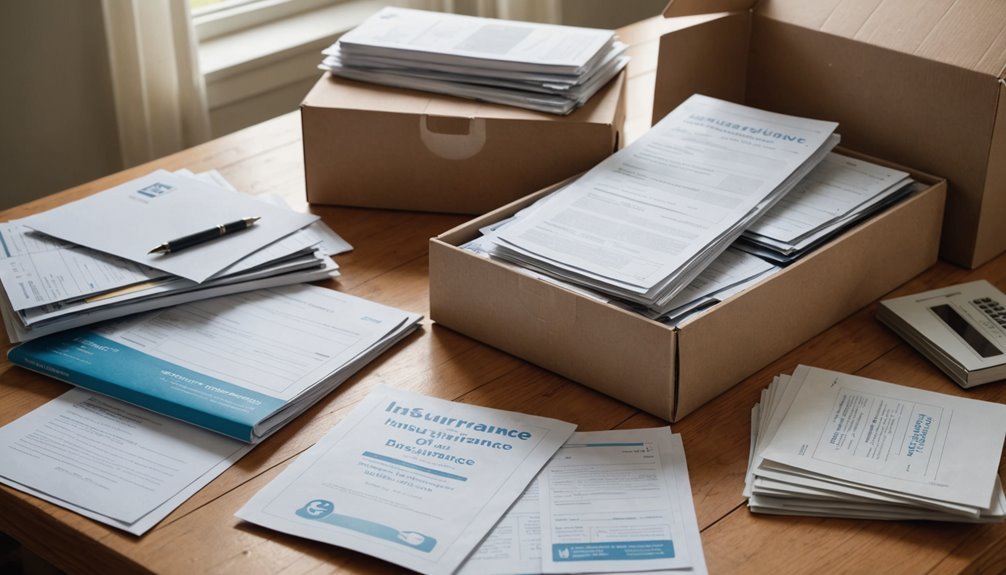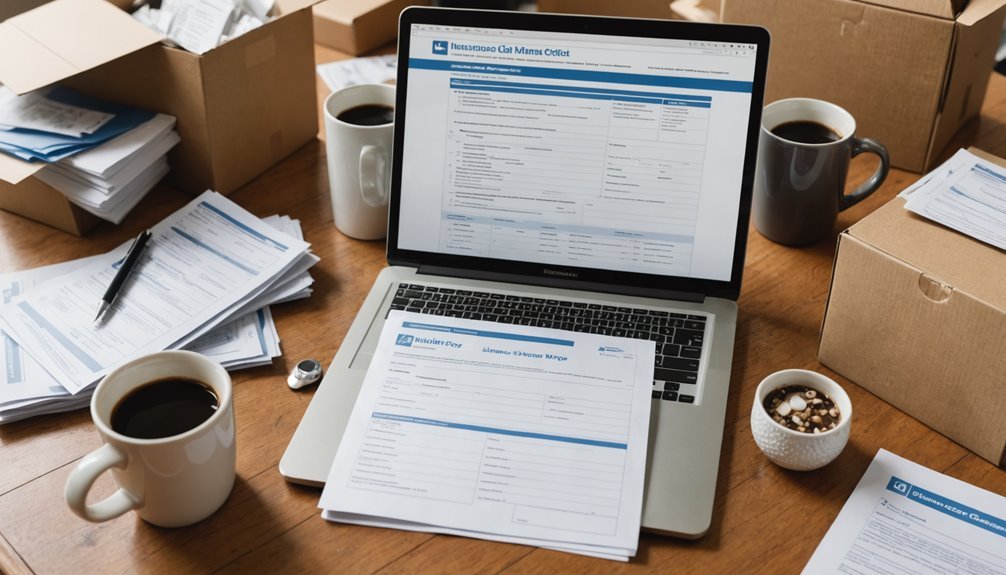When you're planning a move, you might not immediately think about the risks to your belongings. Yet, understanding your insurance options is vital. Are you aware that not all moving insurance options provide the same level of protection? For instance, while Full Value Protection might cover the replacement cost of a damaged TV, Released Value Protection might offer only a fraction of its value. It's important to know the differences to choose wisely. Have you considered what could happen if your items are damaged or lost during the move? Let's explore how to best secure your valuables and guarantee your peace of mind during this hectic time.
Key Takeaways
- Consider Full Value Protection for comprehensive coverage of your belongings at their total replacement cost.
- Evaluate Released Value Protection for minimal, cost-free coverage at 60 cents per pound per item.
- Explore third-party insurance options for additional protection against theft, fire, and other risks not covered by mover's liability.
- Check your homeowners or renters insurance to determine if it extends coverage during your move.
- Understand all insurance terms and document all belongings thoroughly to facilitate any potential claims.
Types of Liability Coverage
When you're planning a move, understanding your insurance options is essential for protecting your belongings. The moving company you choose must provide two types of liability coverage: Full Value Protection and Released Value Protection. These aren't just options; they're mandated by federal regulations to guarantee you're informed and protected.
Full Value Protection holds the mover liable for the total replacement value of your lost or damaged items. However, it's critical to list items of extraordinary value separately to make sure they're fully covered.
Remember, this coverage isn't standardized in cost; it can vary and might include deductibles.
On the other hand, Released Value Protection is offered at no additional cost. Yet, it offers minimal compensation. For instance, if a 25-pound television is damaged or lost, you'd only receive $15 compensation.
That's because the coverage is limited to 60 cents per pound per item, which mightn't reflect the true value of your possessions.
Both options have their merits, but it's important to weigh the potential financial risks. With this knowledge, you can make a more informed decision about which type of liability coverage suits your needs best, making sure your belongings are adequately protected during the move.
Understanding Coverage Options
You must assess your coverage options carefully to confirm that your belongings are fully protected during the move. With differing levels of insurance coverage provided by moving companies, understanding what each option entails is vital.
Here are the key types:
- Full Value Protection: This is the more extensive option, where the mover is liable for the replacement value of damaged or lost items. However, be aware that this option might come with deductibles and the coverage details can vary between movers.
- Released Value Protection: This no-cost option provides minimal protection, compensating at only 60 cents per pound per item. It's less ideal if you're moving items of higher value.
- Third-Party Insurance: For broader protection that covers theft, fire, and disappearance, consider third-party insurance. This can supplement the basic coverage offered by movers.
It's also wise to check your homeowners or renters insurance to see if it covers your belongings during the move. Often, these policies exclude damage done by movers.
Importance of Insurance

After considering the various coverage options available for moving, it's evident why securing moving insurance is so crucial. Moving insurance provides essential protection against loss or damage, safeguarding your belongings from incidents like theft, fire, or accidents.
This coverage isn't just about mitigating risks; it's about guaranteeing financial security. If your valuable items suffer damage or get lost during the move, you're covered financially, allowing you to recover their value without bearing the full brunt of the loss.
With moving insurance, you gain peace of mind. Knowing that your possessions are protected against unforeseen circumstances lets you focus on other aspects of your move without undue stress.
It's a layer of security that handles risk management, reducing the anxiety associated with relocating your life's belongings.
Moreover, moving insurance adheres to federal regulations, providing necessary liability coverage. This not only safeguards your belongings but also guarantees legal compliance, protecting both you and the moving company.
In a process filled with potential pitfalls, moving insurance stands as a crucial shield, guaranteeing that both your financial investment and personal possessions are secure.
Steps to Insure Belongings
To guarantee your belongings are adequately insured during a move, start by selecting a reputable mover that offers clear liability options, including Full Value Protection and Released Value Protection. To further safeguard your possessions, request a written estimate and confirm the moving company’s insurance policies before signing any contracts. Additionally, decluttering before a big move can help streamline the process, minimize the number of items to insure, and potentially reduce overall moving costs. By eliminating unnecessary belongings, you can focus on protecting the valuables that truly matter.
Understanding these options is essential; Full Value Protection covers the replacement cost of your belongings, while Released Value Protection offers minimal coverage, compensating at just 60 cents per pound per item.
Here are a few key steps to verify you're choosing the right insurance for your move:
- Assess Your Belongings: Carefully evaluate the total value of your possessions, paying special attention to high-value items. These might need additional coverage to be fully protected.
- Explore Third-Party Insurance: If the coverage options from your movers don't seem sufficient, consider third-party insurance. This can provide an added layer of protection against potential risks like theft or fire.
- Check Existing Policies: Verify your current homeowners or renters insurance to confirm if it overlaps with the coverage offered by the movers. This helps you avoid paying for redundant insurance while making sure your belongings are protected during the move.
Filing Claims

When your belongings arrive with damage or go missing, it's important to file a claim without delay. Timely reporting is imperative; you typically have up to nine months post-delivery to submit insurance claims, but the sooner, the better. This prompt action greatly boosts the chances of your claim's acceptance and guarantees you meet the deadlines for claim eligibility.
Start by checking the mover's specific procedures for filing claims; each company might've different protocols. It's essential to follow these guidelines meticulously to avoid any complications that might jeopardize your claim.
Verify you've documented everything thoroughly. Keep an extensive inventory list, and make sure you have receipts and clear photos of your items to provide proof of loss or damage. This documentation will be your key evidence in supporting your claim.
Be mindful of packing hazardous materials or perishable items. Movers usually don't cover damages for goods packed in self-packed boxes, which can complicate the claims process.
If you're packing these items yourself, be extra careful and consider if you need additional insurance to cover them. Remember, detailed documentation and reporting promptly are your best tactics for a successful resolution.
Frequently Asked Questions
How to Insure Items During a Move?
To secure your items during a move, choose the right moving insurance.
Check the coverage options, liability limits, and policy exclusions. Understand the claims process and valuation methods.
Opt for Full Value Protection for extensive coverage.
Confirm your packing methods are secure and create an inventory checklist.
Review your moving company's policies, especially around temporary storage.
This way, you'll guarantee you're adequately covered against potential risks during the relocation.
What Insurance Protects Your Belongings?
To guarantee your belongings are protected during a move, consider moving insurance.
Coverage options vary, so review policy details carefully, including liability limits and valuation coverage.
Understand exclusions and how the claim process works.
Assess the risks and compare costs and providers.
Higher-cost items might need additional coverage.
Don't overlook this step; it's essential to evaluate all factors to choose the right insurance for your needs.
How Does a Person Use Insurance to Protect Their Assets?
To use insurance for asset protection, you'll first assess risks and choose a policy with adequate liability coverage and limits.
Opt for valuation options that match your needs. Understand the claims process and prepare by creating an inventory checklist.
Weigh premium costs against potential risks. Use moving tips to minimize damage and choose insurance types that best cover your belongings.
Proper coverage guarantees you're compensated for any losses or damages effectively.
Is Mover Insurance Worth It?
Yes, mover insurance is worth considering.
You'll find different policy types with varying coverage limits, from basic mover liability to full valuation options.
Review the exclusions list and compare costs from several insurance providers.
Check customer reviews and assess the claims process to guarantee reliability.
Don't forget to add insurance tasks to your moving checklist to avoid potential financial losses from damage or loss of your belongings during the move.
Conclusion
In summary, you've got options to safeguard your move. Opt for Full Value Protection for extensive coverage or choose Released Value for minimal compensation. Don't overlook third-party insurance for extra security. Check your current homeowners or renters policy to confirm you're not doubling up. By understanding and selecting the right insurance, you're setting yourself up for a stress-free move. Remember, if anything goes wrong, knowing how to file a claim is essential. Stay protected and move with confidence.


